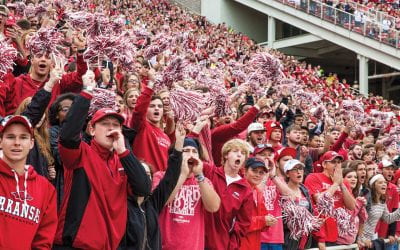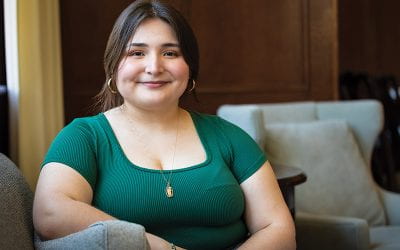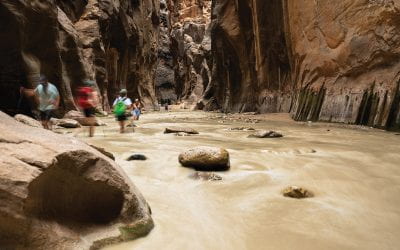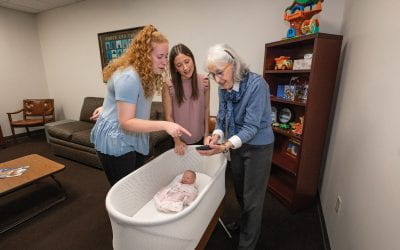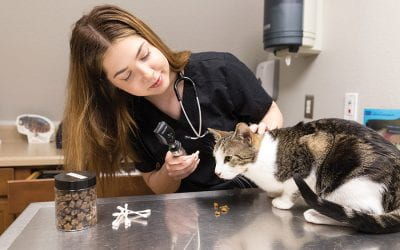
By Kendall Curlee
Photos by Russell Cothren
National Park Service postcard image courtesy of Hot Springs National Park
Renderings by Zane Colvin

When Zane Colvin moved from from rural Wynne, Arkansas, to bustling Hot Springs to attend the Arkansas School for Mathematics, Sciences, and the Arts, he was wowed by the urban energy of his new home, but curious about the hot springs — where were they? He soon discovered that the springs were capped and their thermal waters channeled underneath the town’s main drag, Central Avenue.
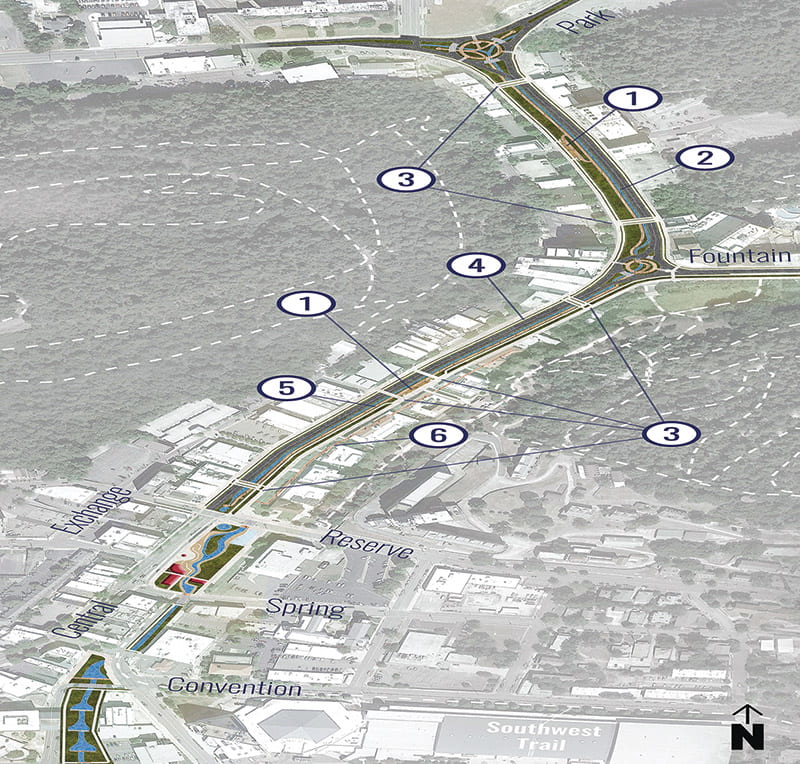
- Entry ramp/staircase
- Continuous daylighted Hot Springs Creek channel (typical)
- Pedestrian and bike bridges
- Bike lanes throughout downtown
- Boardwalk along the Creek (typical)
- Subterranean boardwalk inside the Creek Tunnel
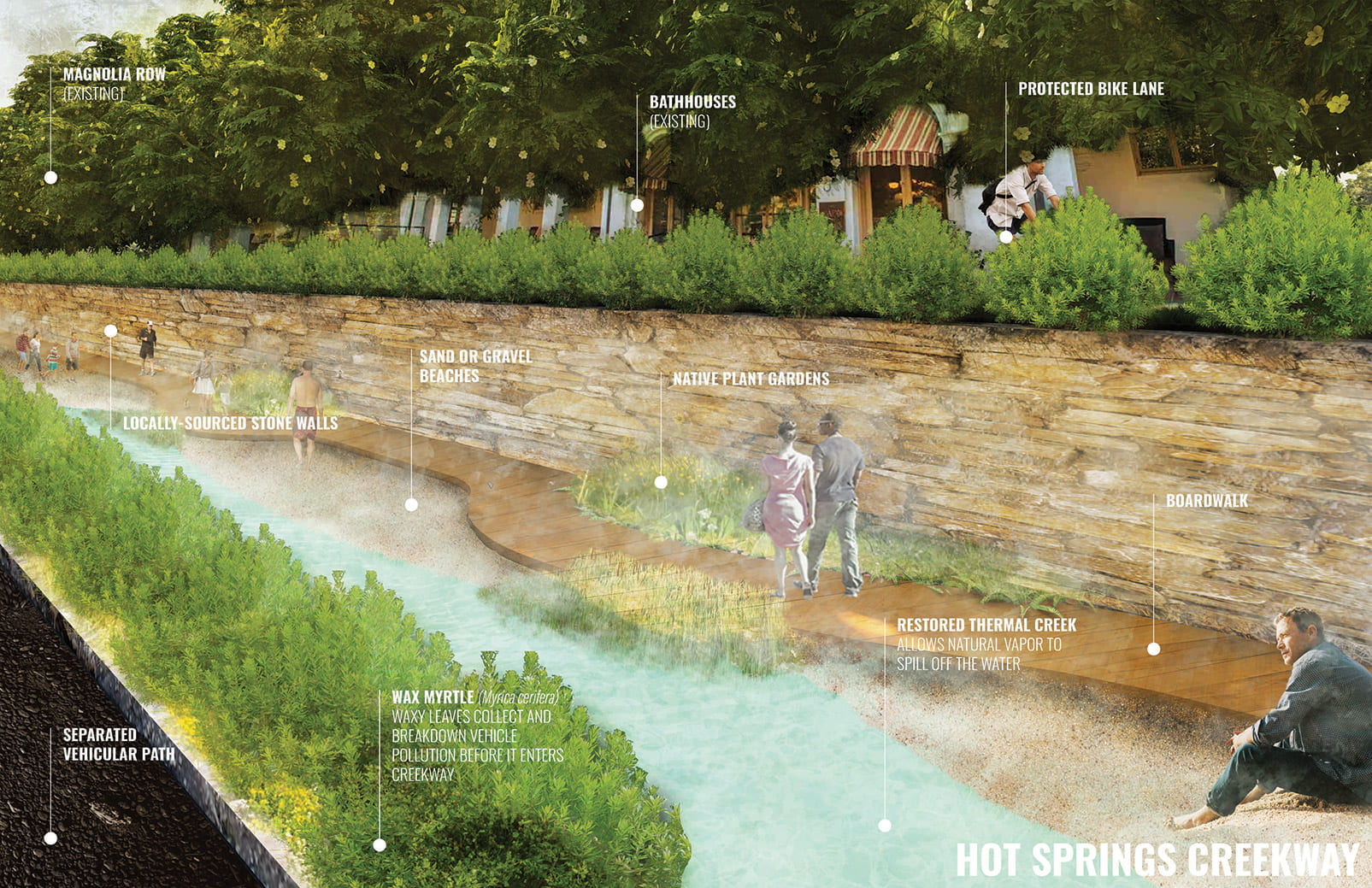
Colvin’s plant palette features thermal spring plants that are native to the area, such as wax myrtle and great blue lobelia
“I learned that Hot Springs had catacombs, just like Paris, but it’s not dead people down there; there’s a giant tunnel, 10 feet tall and 20 feet wide, with water flowing through it for the past 150 years.” Colvin wondered what it would take to…
“Bring nature and the water to the forefront, so people can actually see it and experience it when they go to Hot Springs.”
He explored some ideas and made some sketches in high school, but lacking the necessary design chops, put the project aside.
Five years later, as a landscape architecture major at the U of A, Colvin devoted his honors thesis project to developing a game-changing proposal for Hot Springs: Uncover the thermal waters flowing through downtown and create boardwalks that would allow visitors to see and touch the water that put the town on the map. Colvin also envisioned an improved walking, biking and transit system that would tie into the 26 miles of trails in adjacent Hot Springs National Park.
He began with a deep dive into researching the history of Hot Springs, and a volley of emails and phone calls to park and city officials, requesting access to the tunnel beneath Central Avenue. Finally, after connecting with stormwater department staff who agreed to guide him, Colvin donned his duck waders. Clutching a GoPro in his left hand and the rope in his right, he rappelled down a steep wall into a concrete tunnel heated by 100-degree-plus thermal waters with “almost no life in there” except for a stray cockroach or two.
But as he progressed through the tunnel to a brick section built in the ’50s and on to the original tunnel built in 1884, Colvin was struck by the look of the hand-hewn stone and the sound of the rushing water: “It was really, really beautiful. All of the water was completely crystal clear and smelled nice, like minerals; at different points, cascades and waterfalls surround you.” The two-plus hours that Colvin spent underground changed his mind about the tunnel. “It’s this gorgeous environment that should be appreciated, should be preserved, and should be made more natural — and right now it’s hidden in a pipe underground. I think it’s something that people would really want to see if given the chance.”
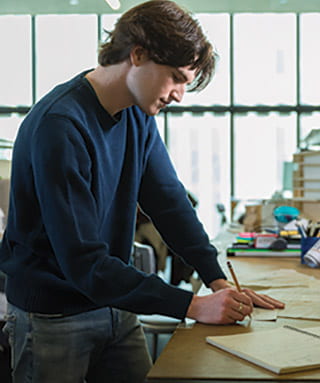
Following visits to design precedents in Texas — San Antonio’s River Walk and Austin’s Barton Springs Pool — Colvin got down to work, mapping out some major changes for Hot Springs in a series of seven incremental phases. First up, he would uncover the thermal waters in Bill Clinton Park and a new park sited on a former parking lot, both located south of Bathhouse Row. These parks offer plenty of space and could connect to existing trails. In phase two, he would open the centers of two roundabouts north of Bathhouse Row into apertures on the creek below, surrounded by native plantings. His master plan also calls for putting Central Avenue on a ‘road diet,’ narrowing the street from four lanes to two with a turning lane, which would calm traffic and open space for bike lanes.
Later phases open sections of Central Avenue to the thermal waters below, with perhaps the most ambitious phase being the construction of a “false creek” in front of the landmark spas that define Bathhouse Row. “The real creek goes directly in front of the bath houses and in some spots, even flows directly beneath their foundations,” Colvin explained. “There’s no way to excavate the creek where it currently flows without destroying Hot Springs’ most important tourist attraction and irrevocably damaging the city’s cultural history.”
Influenced by his underground excursion, Colvin would like to create boardwalk access between the new creek and a section of the historic tunnel. “It’s something people are curious about,” he said. “The environment is not natural but it’s historically significant, and unlike anything else in the city.”
It’s an ambitious plan, to be sure. Landscape architecture professor Jim Coffman, Colvin’s thesis mentor, praised him for doing “an amazing amount of work. This easily could’ve been an entire studio, with lots of students working on it.”
This fall Colvin will begin studies towards a master’s degree in community and regional planning at the University of Texas at Austin. There, he hopes to take his master plan to the next level, estimating costs, developing tax proposals and creating an economic impact plan.
The biggest challenge, he feels, is helping people see how the state’s “number one tourist attraction could be better … Even if the city just did part of the proposal, it would completely change how people see Hot Springs, completely change how they’re interacting with it, and finally give the water back so they could access it and enjoy it.”
Colvin’s research was supported by a SURF grant.
More Field Notes
Brand Fans
For her honors thesis, Madeline Braun explored how the Kansas City Chiefs and the Razorbacks cultivate identity loyalty within their own brands. To find the secret sauce, she distributed a survey asking both Chiefs and Razorbacks devotees to answer questions about their sense of pride and loyalty in their team.
Colorblind Quadrilles? A Closer Look at Bridgerton
For her honors thesis, senior political science major Daniella Ruiz Cantú knew that she wanted to combine her studies in both sociology and political science with her interest in film. She was confused why, despite numerous successful films featuring people of color front and center — like Coco and Crazy Rich Asians — she continued to encounter racism in the news and in person. After taking Lisa Corrigan’s honors colloquium in communications, she learned of one possible explanation: the reinforcement of the white gaze in media.
A New Angle On Climate Change
Dawson Oakley, a biological engineering senior, Honors College Fellow and hobbyist videographer with a passion for the outdoors and sustainability, decided to merge his interests by developing a video that raises awareness about climate change issues and showcases how engineering is being used to mitigate them.
Up All Night? Enter A.I.
Gabrielle Krupa, a senior communications sciences and disorders major, and Sutton Bauman, a senior communications sciences and disorders major with a background in human development, set out to explore how new technologies impact how parents bond with their newborn children.
Pandemic Pet Care
Animal science majors Kayla DeSmet and Sabrina Cox labored in the trenches throughout the pandemic — DeSmet working at a hospital for small and exotic animals in Fayetteville, while Cox learned the ropes at a Tontitown clinic that cares for pets and livestock. For their honors thesis research, they decided to document COVID-19’s day-to-day and long-term impacts on the companion animal industry from 2020 to 2021.
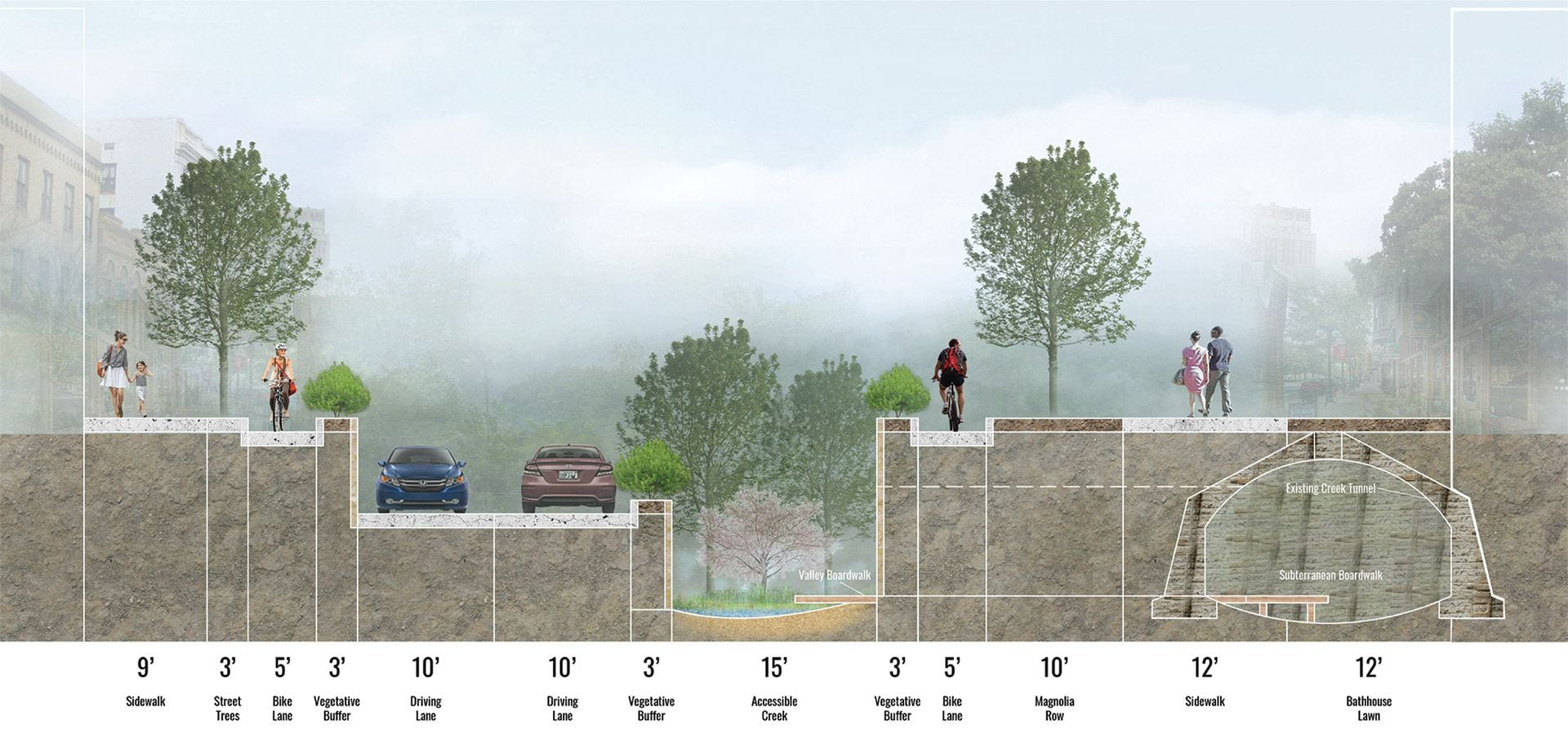
The multi-level plan accommodates a tight corridor and enhances safety by separating pedestrians and cyclists from cars.


